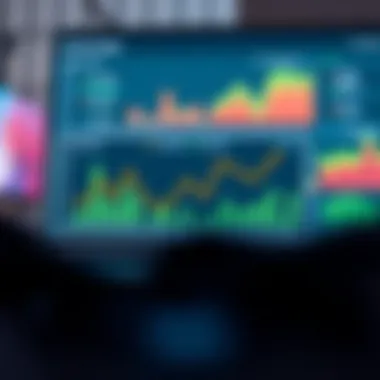Mastering Monthly Budget Graphs for Financial Success


Intro
Navigating your finances can sometimes feel like swimming with weights tied to your ankles. Understanding where your money goes and how to manage it effectively is crucial for both short-term stability and long-term prosperity. One potent tool that many overlook is the monthly budget graph. These graphs don’t just present numbers; they tell stories and reveal trends that can guide decisions and shape future plans.
In this article, we will cover essential aspects of creating and interpreting these graphs. From understanding the terminology that underpins financial conversations, to the expert insights that can help refine your strategy, our aim is to equip you with the knowledge needed to enhance your financial literacy and investment skills.
Investment Terminology
Understanding the jargon of finance is like having a map before venturing into unknown territories. Knowing the language helps in making informed decisions.
Key Terms and Definitions
Here are some fundamental terms that will serve you well in the realm of budgeting and investing:
- Cash Flow: The amount of cash being transferred into and out of your accounts. Monitoring cash flow is pivotal for maintaining liquidity.
- Variance: The difference between planned spending and actual spending. Understanding variance can highlight trends in your budget management.
- Discretionary Spending: Money spent on non-essential items. It’s often useful to distinguish between needs and wants.
- Fixed Costs: Regular payments that don’t change month to month, such as rent or insurance. They are stable yet can be burdensome if not monitored.
- Net Worth: The total assets minus total liabilities. This metric gives insight into your overall financial health.
Common Acronyms in Finance
Abbreviations can often lead to communication gaps. Familiarizing yourself with common acronyms equips you better in discussions around finances:
- ROI: Return on Investment. A measure of the profitability of an investment.
- FICO: Fair Isaac Corporation, which provides credit scores that can greatly influence loan approvals and interest rates.
- APR: Annual Percentage Rate. The interest rate for a whole year, rather than just a monthly fee.
- GDP: Gross Domestic Product. An important indicator of a country’s economic performance.
"Understanding financial terms is like having a compass; it helps you navigate through the complexities of the financial landscape."
Expert Insights
Now that we have a firm grasp of the basics, let’s delve into some strategies and tips from those who’ve navigated these waters successfully.
Investment Strategies Overview
Strategies can vary widely based on individual circumstances and goals. Here are a few methods:
- Diversification: Investing in a range of securities to reduce risk.
- Cost Averaging: Regularly investing a fixed amount to beat market volatility.
- Retirement Accounts: Maximizing contributions to tax-advantaged accounts to secure your future.
Tips from Financial Advisors
Here are some golden nuggets of advice from financial experts:
- Always review your budget graph regularly—make adjustments as your circumstances change.
- Set specific, achievable goals. It's much easier to stay on track when you have clear objectives.
- Don’t overlook the importance of emergency savings. It’s like having a safety net for life’s unexpected events.
Incorporating these insights into your approach will not only help clarify your financial status but also poise you for making informed decisions moving forward.
Understanding Monthly Budgeting
Managing our finances can often feel like trying to navigate a labyrinth. However, at the core of effective financial management lies the concept of monthly budgeting. This practice serves not only as a roadmap for personal spending but also as an essential tool for enhancing financial literacy. Understanding monthly budgeting means grasping the intricacies of tracking income against expenses, which helps in making informed decisions about where to allocate resources.
A monthly budget is essentially a plan that outlines expected income and expenses for a month. It helps individuals set financial goals, whether it's saving for a rainy day, paying off debt, or planning a trip. Regularly reviewing and adjusting one's budget cultivates a deeper understanding of spending habits and financial commitments. This understanding is crucial because it allows individuals to distinguish between wants and needs, paving the way for more disciplined financial behavior.
Some specific benefits of an effective monthly budget include:
- Enhanced awareness of personal financial status.
- Better control over discretionary spending.
- The ability to set and reach financial goals more effectively.
- Reduced stress related to financial matters.
When we comprehend the basics of monthly budgeting, it encourages us to take charge of our finances rather than letting them dictate our lives. A solid budget serves as a foundation, providing insights that facilitate healthier financial practices over the long haul.
The Basics of a Monthly Budget
Creating a monthly budget doesn't have to be a daunting task. It begins with gathering financial information, which includes all sources of income and a detailed list of monthly expenses. Income can stem from salaries, freelance work, or rental properties, while expenses can branch into fixed costs, such as rent and insurance, and variable costs, like groceries and entertainment.
To construct a basic budget, follow these steps:
- Calculate Total Income: Add up your sources of income for the month.
- List Expenses: Document all monthly expenses, categorizing them into fixed and variable.
- Subtract Expenses from Income: This gives you a good idea of your financial health.
- Set Goals: Prioritize savings, debt repayment, or investments based on your overall financial aspirations.
Using a budgeting template or tool can streamline this process. Many find spreadsheets, whether in Excel or Google Sheets, to be useful for laying everything out in a user-friendly format. Alternatively, there are specialized budgeting apps that can simplify tracking and adjusting expenses on the go.
Why Monthly Budgeting Matters
The significance of monthly budgeting cannot be overstated. It acts as a beacon, guiding individuals toward financial stability amidst the chaos of daily expenses and unexpected costs. One reason budgeting matters is the allowance it provides for proactive financial planning rather than reactive financial maneuvers. When people stick to their budgets, they often avoid the pitfalls of overspending and falling into the trap of credit card debt.


Moreover, budgeting maintains a sense of accountability. It encourages individuals to recognize and question their purchasing decisions, leading to more mindful spending. This change in perspective can shift focus from immediate gratification to long-term financial well-being.
"A budget is telling your money where to go instead of wondering where it went."
Additionally, monthly budgeting often results in better preparedness for future uncertainties. Whether it's unexpected medical bills or a home repair emergency, having a financial cushion due to careful budgeting creates peace of mind.
The Role of Graphs in Financial Analysis
In a world dominated by data, how one chooses to visualize this information can make a world of difference. Graphs transform raw numbers into compelling visuals, making complex financial data more accessible and understandable. This section zeroes in on why graphs hold a pivotal position in analyzing financial trends and making sound decisions.
Visual Representation of Financial Data
Financial data, on its own, often feels like a mountain of numbers, each figure vying for attention. When you look at spreadsheets filled with rows and columns of data, it can easily become overwhelming—enough to make one’s head spin. However, when these figures are bartered in the language of visuals, they begin to tell a story.
Graphs take those intimidating numbers and turn them into something relatable. For instance, imagine you are evaluating your monthly expenditures; simply laying out the amounts doesn’t clarify where your budget might be overspending. A pie chart, however, slices your spending habits into easily digestible sections. Instantly, you can see which categories are eating up the lion's share of your budget. This kind of visual can help unveil insights about spending habits that might remain obscured in a table of figures.
Further, the transition from data to graph can help highlight comparisons across categories or over time. A line graph, for example, could depict your monthly income against your expenditures over several months, illustrating not just where your finances stand now but also where they have been heading. Here’s a thought: without these visual aids, important trends could slip under the radar—subtle shifts that warrant attention could remain unnoticed until it’s too late.
Benefits of Graphical Data Presentation
The advantages of using graphs in financial analysis are numerous, extending beyond mere aesthetics. They can help you draw quicker conclusions and help stakeholders engage more effectively. Here are several key benefits:
- Clarity and Comprehension: Graphs present information in a straightforward manner. Viewers grasp information at a glance, reducing the time and effort needed to interpret financial data.
- Highlighting Trends: The ability to quickly observe trends aids in forecasting and strategic planning. Recognizing that expenditures have spiked over the past few months, for example, can lead to early intervention and corrective measures.
- Facilitating Communication: When presenting financial information to stakeholders—be it a board, investors, or even family—visuals create a common language. Graphs provide a focal point of discussion, making it simpler to convey your message.
- Improved Decision Making: Based on the insights gained from these visuals, decisions can be made swiftly and with greater confidence. The narrative built by the graph can support action plans, making them rooted in actual data.
"A picture is worth a thousand words," and in the realm of finances, a well-crafted graph can be priceless.
By utilizing graphs effectively, both novice and seasoned investors enhance their financial cognizance and facilitate better decision-making processes. As we move forward, understanding these aspects will lay the groundwork for constructing meaningful budget graphs.
Constructing Your Monthly Budget Graph
Building a monthly budget graph is more than just a task you can tick off your to-do list; it's a significant component of smart financial management. This section explores how you can create a precise and purposeful graph that serves your budgeting goals. Think of it as crafting a map that guides you through your financial landscape. You wouldn't embark on a journey without knowing the lay of the land, and the same applies to your finances.
Selecting the Right Type of Graph
Choosing the appropriate graph type is crucial. It hinges not only on the data you have but also on how you want to communicate that information. Let’s take a closer look at the three main contenders in this arena.
Bar Graphs
Bar graphs are akin to those bulging biceps you see at the gym; they pack a punch. They showcase quantities visually, allowing one to compare funds allocated across different categories, such as food, rent, and entertainment. Their most compelling feature is straightforwardness—each bar’s height easily indicates your spending levels, making it a popular choice for beginners and seasoned experts alike. However, while they shine in comparative analysis, they may obscure detailed patterns or trends over time that some users find essential.
Pie Charts
On the flip side, pie charts slice your budget into digestible portions. They illustrate how much of your total budget each category consumes. The beauty of pie charts lies in their visual appeal; they provide an immediate snapshot of your financial distribution. However, the downside is that with more than five or six categories, the slices can get so small that they become hard to interpret. So, while a pie chart might look good on paper, it risks oversimplifying your financial reality if used on complex budgets.
Line Graphs
Line graphs are a favorite for tracking changes over time. They create a visual flow that captures your spending patterns like a fine wine aging in an oak barrel, showing shifts month-to-month or week-to-week. By connecting various data points, they help you visualize trends such as rising expenses or fluctuations in income. However, if you have a lot of data points, line graphs can become cluttered and messy, sometimes leading to more confusion than clarity.
Gathering and Inputting Data
Now that you've selected the right graph type, the next step revolves around sourcing your budget data. You’ll want to gather everything from monthly incomes to recurring expenses. Transaction records, bank statements, and budget tracking apps can be invaluable in this phase. The aim is to provide a holistic view of your financial obligations. Inputting this data correctly is imperative; a small error can distort your entire graph, leading to erroneous conclusions about your spending habits.
Tools and Software for Graph Creation
When it comes to graph creation, the tool makes a difference. Here are a few options:
Excel
Excel is like the Swiss Army knife of spreadsheets. Its versatility allows for intricate calculations, data sorting, and, of course, graphing. It shines in dealing with large data sets. One downside is that it may feel a bit overwhelming for beginners due to its many features, but once you get the hang of it, the possibilities are nearly endless.
Google Sheets
Google Sheets stands close to Excel but brings a collaborative edge. Sharing your budget with family or partners becomes a breeze, making it ideal for joint budgets. The only drawback might be its limited functionality compared to Excel, especially in terms of graphing complex datasets. However, for basic to moderate level budgets, it shouldn't fall short.
Specialized Budgeting Apps
Specialized budgeting apps like Mint or You Need A Budget offer user-friendly interfaces designed specifically for financial tracking. These tools often streamline the data input process and provide automatic updates, making it easy to keep an eye on your finances. One limitation is that these apps might not cover all graphing options you're looking for. Additionally, privacy concerns regarding how data is handled can deter some users from diving in.


As you move forward, don't overlook the vital role this graph will play in refining your budgeting strategies. Remember, it's a journey, not a one-time event.
Interpreting Your Budget Graph
Interpreting a budget graph isn’t just about looking at the data; it’s about understanding the story it tells about your finances. Each graph can reveal trends, signify changes, or call out areas where adjustments are necessary. This process holds significant weight for both novice budgeters and experienced investors alike, offering a detailed roadmap through complex financial landscapes.
Understanding these graphical representations forces you to engage with your spending and savings decisions more critically. It becomes a lens through which you can gauge success or pinpoint trouble areas. One crucial element to keep in mind is that the format of the graph—whether it be a bar chart or line graph—can impact how you perceive the information displayed. For instance, a pie chart might give you a quick snapshot of how your budget is allocated across categories, while a line graph can provide insights into trends over time.
Identifying Trends and Patterns
When diving into your budget graph, the first thing to focus on is the identification of trends and patterns. These insights can act as guiding stars for future financial decisions. Let’s break it down:
- Consistency vs. Variability: Look for regular patterns. Are there months where spending increases significantly? Understanding cyclical expenses—like holiday spending—can help you plan better for those spikes.
- Seasonal Impacts: Certain expenses might rise and fall due to the seasons. For example, utility costs might soar in winter, while travel expenses might jump in summer.
- Growth Patterns: Are you consistently spending more in specific categories? This could highlight areas that need trimming or adjustment.
The ability to track these trends over time can illuminate both strengths and weaknesses in your financial behavior. Over an extended period, you can recognize what changes are necessary to align with your long-term financial goals.
Understanding Anomalies in Data
Anomalies can throw a wrench into the works. Understanding strange spikes—or dips—can be vital for maintaining the integrity of your budget. Here’s how to approach anomalies:
- Investigate Unusual Variations: If a category shows abnormal spending, it might warrant more inquiry. For instance, if dining out expenses suddenly double, consider what catalyzed that shift—was it a special occasion, or are you developing a trend of overspending?
- Contextual Evaluation: Consider the context surrounding these anomalies. Were there one-off purchases? Did an unexpected expense crop up? Understanding the why makes all the difference in your responses moving forward.
- Data Integrity: Anomalies can sometimes stem from errors in inputting your data. Double-check that everything is entered correctly to avoid making decisions based on faulty information.
As you engage in interpreting your budget graph, remember that these insights are not just numbers on a page; they are calls to action. By grasping both trends and anomalies, you can navigate toward more responsible financial habits and make adjustments that will yield greater fiscal health down the road.
"A graph is worth a thousand numbers."
Common Mistakes in Budget Graphing
When diving into the world of monthly budget graphs, understanding common mistakes is akin to knowing the pitfalls before you start your journey. This section sheds light on two significant errors often encountered by both novices and seasoned financial enthusiasts alike. Avoiding these gaffes can make a world of difference in how effectively one can convey financial data and insights.
Misleading Representation of Data
Misrepresentation of data happens when a budget graph fails to accurately depict the underlying numbers. This mistake can easily mislead the audience. For instance, consider a pie chart illustrating monthly expenses. If one category takes up a disproportionate amount of space without proper scaling, it can give the impression that it represents a much larger segment of spending than it actually does.
- Key Points to Keep in Mind:
- Always use consistent scales and proportions.
- Provide context for the figures; a label is not just a nice touch, it’s essential.
- Be wary of data selection biases. Presenting only the positive aspects of your budget while omitting or downplaying negative figures can skew perception.
Don’t let fancy graphics overshadow the truth. Instead, let clarity be your guiding star. Graphs should aim to educate, not confuse.
"Transparency isn't just a buzzword; when it comes to budget graphs, it's invaluable."
Overcomplicating Graphs
Overcomplication in budget graphs can drown the message you’re trying to convey. More often than not, people tend to add too much information, presenting graphs that look like a cluttered mess rather than a helpful tool. This not only frustrates the readers but also obscures critical data.
- Common Signs You May Be Overcomplicating:
- Using too many data points: Stick to the most pertinent information.
- Excessive color use: Each color should have a clear purpose, not just be a pretty addition.
- Multiple graph types in one chart: Keep it unified; mixing line graphs with pie charts can confuse your audience.
Remember, less is often more. The aim is to create a graph that enables viewers to understand and interact with the data intuitively. A clean and straightforward graph fosters better decision-making, helping one grasp financial realities without unnecessary distractions.
Practical Applications of Monthly Budget Graphs
Monthly budget graphs serve not just as tools for visualization, but as powerful instruments for strategic financial decision-making. Utilizing these graphs effectively can lead to well-informed choices that align with one’s financial goals, whether they be personal aspirations or business objectives. The capability to see the ebb and flow of income and expenses visually can be transformative for anyone striving for greater fiscal control.
One major benefit of leveraging monthly budget graphs is the ability to simplify complex data. When income statements or expense reports become a tangle of numbers, visual representation can slice through the confusion. Stakeholders or even personal users can quickly grasp where money flows in and out, identifying patterns that may not be obvious at first glance.
"Graphs take the guesswork out of budgeting, making it crystal clear where adjustments need to be made."
Moreover, these graphs foster an environment where informed decision-making thrives. Instead of making blind choices about expenditures, people can lean on concrete data. For instance, an entrepreneur faced with a financial shortfall can refer to their budget graph, recognizing trends in overspending categories, which can then lead to precise adjustments in areas like marketing or operational costs.
Using Graphs for Financial Decisions
The crafting of smart financial decisions hinges on the clarity of data presented. When individuals or businesses employ budget graphs, the visualization can illuminate areas where savings can be realized or investments made.
- Trend Analysis: Regularly updating a monthly budget graph allows users to spot trends over time, such as increasing costs in certain categories. Recognizing these trends can lead to proactive measures, like cutting back on subscriptions that no longer provide value or reallocating funds to more profitable ventures.
- Goal Tracking: Graphs can also keep a financial plan on track. For example, if someone aims to save for a house, tracking their progress through graphs can help maintain motivation and adjust strategies as needed.
- Scenario Planning: By simulating different scenarios through what-if analyses, a graph can show potential outcomes based on altered expenditures or income adjustments, equipping users with foresight for making choices.


With this understanding, both novices and experienced investors can hone in on their financial strategies, turning data into actionable insights.
Enhancing Communication with Stakeholders
Effective communication is key in any financial venture, and budget graphs facilitate discussions among stakeholders seamlessly. Whether it's families discussing household expenses or business partners assessing fiscal health, visuals can clear a path through complex conversations.
- Clear Presentation: The direct visual nature of graphs makes them much more digestible. Instead of overwhelming audiences with figures, stakeholders can intuitively comprehend financial positions through easily interpretable visuals.
- Fostering Collaboration: When everyone has access to the same graphical data, collaboration improves. Decisions become closely tied to evidence rather than opinions, reducing conflicts and enhancing unity among team members. Partners can unite behind common goals, driving toward shared financial aspirations.
- Supporting Proposals: Presenting a budget graph during a meeting can provide a solid foundation for proposals or pitches. It substantiates claims about financial needs or potential for growth, reinforcing the message with data.
For further learning and resources, you might consider visiting sites such as Investopedia, which offers insights into budgeting strategies, or Coursera, for online financial courses.
Evolving Your Budget Over Time
In the rapidly changing landscape of personal finance, the ability to adapt one’s budget is not just beneficial but essential. Understanding how to modify your budgeting strategies is akin to navigating through a river — at times, you may need to steer around boulders or shift course altogether. As economic conditions, life events, or personal goals shift, maintaining a static budget can leave you adrift. Here, we will discuss the significance of evolving your budget and how to adjust your strategies while leveraging graphical tools for long-term planning.
Adjusting Your Budgeting Strategies
Change is the only constant in life, and this rings especially true when it comes to personal finances. Reviewing and adjusting your budget on a regular basis is crucial. Here’s why:
- Responsive Planning: The cost of living can fluctuate with no warning. If a sudden price hike occurs in your utility bills or grocery costs, you need to reassess your budget quickly. Those who embrace flexibility can avoid the pitfalls of overspending or running into debt.
- Reflecting Life Changes: Major life events, whether it’s a new job, marriage, or the birth of a child, alter your financial picture. Moving expenses or childcare needs will push you to re-evaluate your spending and savings goals. In such cases, a budget graph can visually highlight these changes, making adjustments more tangible.
- Realistic Financial Goals: Sometimes you might find that your goals have outstripped your means, or perhaps a recent promotion creates opportunities for enhanced savings. Adjusting your budget allows you to set achievable targets, reducing the chances of feeling overwhelmed by unrealistic expectations.
Utilizing graphs during these adjustments enhances clarity. For instance, if your expenses in one category are consistently higher, a pie chart can demonstrate this drain on your overall finances, prompting actionable changes.
Long-term Financial Planning Through Graphs
The significance of graphs extends beyond mere observation; they are a fundamental tool for long-term planning. When you harness the power of data visualization over time, you can draw powerful insights:
- Tracking Progress: With line graphs, you can easily track your financial trajectory. Are your savings growing? Is your debt declining? These visual representations allow you to see patterns that may have otherwise gone unnoticed. The trend lines can indicate whether you need to double down on savings or if you can afford to loosen the purse strings a little.
- Forecasting Future Needs: Your budget not only reflects your current state but may also help predict future financial requirements. For instance, if you see a consistent increase in your expenditure on education, it might mean planning for tuition fees sooner rather than later. Understanding these trends visually empowers you to make informed decisions today for a healthier financial tomorrow.
- Adjusting to Economic Changes: In the face of inflation or economic downturns, having a long-term view can make all the difference. By regularly updating your budget graph, you can shift your focus on investments or savings that are more likely to yield positive returns.
“A budget is telling your money where to go instead of wondering where it went.” – John C. Maxwell
Resources for Continued Learning
In the world of budgeting, staying informed is as vital as the act of budgeting itself. Constantly evolving financial landscapes require an adaptive mindset and a thirst for knowledge. This section emphasizes the importance of continual learning in mastering monthly budget graphs, essentially acting as a bridge between mere understanding and actual proficiency. The learning resources presented here cater to diverse needs, providing users various avenues to deepen their skills.
Books and Guides on Budgeting
Books are an invaluable resource, often serving as compendiums of knowledge compiled by experts from their real-world experiences. For those venturing into budgeting, consider the following titles:
- "The Total Money Makeover" by Dave Ramsey: This book offers straightforward budgeting principles, tailored to help you build a sound financial foundation.
- "Your Money or Your Life" by Vicki Robin: A classic in personal finance literature, it emphasizes not just budgeting but reforming your relationship with money overall.
- "The Barefoot Investor" by Scott Pape: Perfect for beginners, it presents budgeting in a manageable yet effective way, making it easier to secure your financial future.
Books like these lay solid groundwork in budgeting strategies and mindset. They tend to include practical exercises, real-life examples, and easy-to-grasp methods for tracking finances, helping readers shift from theory to practice with ease.
Online Courses and Workshops
In addition to books, online courses and workshops provide an interactive way of learning. These platforms offer visual content, community engagement, and often real-time support. Popular options include:
- Coursera: Partnered with universities, it offers courses in personal finance and budgeting, combining theory with practical assignments.
- Udacity: Known for its more tech-focused courses, you can find budgeting and finance classes that will deepen your analytical skills about financial data.
- Skillshare: This platform has a variety of workshops hosted by financial experts, focusing on creating and interpreting budget graphs.
Engaging in these courses not only enhances your knowledge but connects you with fellow financial enthusiasts. It’s like being part of a community, sharing insights, and learning from each other’s experiences.
"Education is not the filling of a pail, but the lighting of a fire." - William Butler Yeats
Staying informed is an ongoing journey. These resources help to cultivate a mindset that embraces continuous improvement in financial literacy. They empower both novice and seasoned investors to grasp budgeting concepts thoroughly and effectively utilize monthly budget graphs for informed decision-making.
Final Thoughts on Monthly Budget Graphs
Budget graphs aren't just pretty pictures; they are reflective tools that can show where you stand financially, at least as best as the data allows. Drum roll, please: your monthly budget graph is a roadmap. It illuminates the ups, downs and all those little wiggles in between that are your spending and saving habits.
The Importance of Continual Assessment
When looking at financial graphs, it's crucial to understand that it’s not a 'set it and forget it' kind of deal. Continual assessment of your budget is necessary for keeping your financial ship on course. Take a step back every now and then and assess what's working and what's not. Here are a few points to ponder:
- Regular Check-ins: Look at your graphs monthly. Are your expenses creeping up like a thief in the night? You’re not just looking at data; you’re watching your money's behavior over time.
- Adjusting Strategies: Maybe your current spending plan isn’t cutting the mustard, or perhaps it is—but don’t think for a minute that you can’t tweak things. Life happens; unexpected expenses or changes in income can throw a wrench in even the best-laid plans.
- Identifying Trends: Continual assessment allows you to spot trends before they become significant issues. For instance, if a category like dining out is consistently high, you’ll notice it before the credit card bill comes due.
"Monitoring and adjusting your budget graph is not just a task; it's a habit that cultivates financial awareness."
Empowering Financial Responsibility
You can't toss responsibility to the wind and expect to fly; that's just not how it works. Monthly budget graphs help you take the reins of your financial life.
- Understanding Your Finances: With a visual representation of your budget, it’s like having a cheat sheet for your spending habits. You know where your money is going and can make informed decisions. Informed decisions lead to responsible spending, and responsible spending builds wealth over time.
- Goal Setting: Your budget graph isn’t just a reflection of the past; it can also be a guiding star for your goals and aspirations. Want to save for a vacation or a down payment on a house? See how changes in your spending can help you reach those milestones.
- Accountability: A graph not only tells a story; it turns you into the narrator. By regularly reviewing your budget, you hold yourself accountable. If you know others will see your progress—like a spouse or a financial advisor—you might think twice before splurging.
As you chart your financial course, remember that there's no quick fix. Title and details aside, mastering the art of budgeting is a journey that requires patience and perseverance. Your monthly budget graph is simply a tool on this path, guiding you each step of the way.















